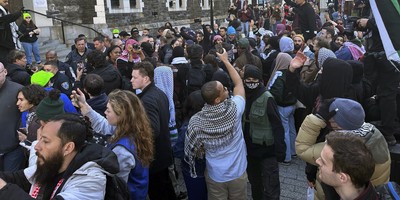European anarchists in the late 19th century relied on three technologies to commit and then transform human massacre into international political terrorism: the railroad, improved explosives and the telegraph.
Railroads permitted rapid city-to-city travel. Mobile terrorists could scout and then strike soft targets of iconic significance. Improved explosives gave small bands of extremists massively destructive power. The telegraph served as a global megaphone.
Steam-powered iron horses dispensed with the horse teams rapid long-distance transit required and only the wealthy could afford. By the 1880s, western and central European rail provided quick and comparatively inexpensive transport. Our first scenario: From a mainline Austrian bahnhof, a Russian anarchist could quickly bring his violent anti-czarist struggle to a Parisian street.
Improved explosives (TNT was a quantum leap) miniaturized mass murder. Handbags became lethal camouflaged bombs, perfect for turning a chic boulevard cafe into a killing field. Anarchist tracts praised the new explosives. Kings and capitalists were vulnerable. Their police could not protect them or the benighted publics supporting their regimes. Moreover, a terrified public was politically vulnerable.
As for the telegraph, over its lines news of the deed spread virally across Europe and the Atlantic at the speed of light. Hello, modern media and their bastard offspring, modern propaganda by the deed.
Recommended
Modern airline systems are just a faster rail system, with global connectivity. Jumbo jets are an economic boon. Terrorists, however, can hijack them or use them to commute from Yemen to Detroit. Granted, the Boston terrorist could have been a local. However, the jampacked Boston Marathon crowd was a soft, iconic target with global resonance. In 1894, a French anarchist tried to blow up Britain's Greenwich Observatory (the prime meridian). He failed, but his target had global significance.
Don't damn improved explosives as the unmitigated evil in this mix. Explosives make modern infrastructure possible. Dynamite dug the Panama Canal and created interstate highways. However, the miniaturization of mass lethality presents security agencies with immense problems. I read a report claiming that one Boston bomb was a "low-power" homemade explosive device hidden in a trash can. Terrorists in the late 19th century hid homemade bombs in trash bins. The trick remains deadly. Our second scenario is not 19th-century; nuclear weapons won't fit in a handbag or standard trash can, but a terrorist could stash one in an SUV.
A 21st-century smartphone is just a highly lateral miniaturized telegraph, with audio, video and Internet capability. These phones link the globe. Try prying a smartphone from the hands of a teenager in Rome or Seoul. I love them; they do threaten dictators. The Internet, however, like its mass media predecessors, is rife with rumors, propaganda, sensationalism and spin, which cloud logic and prey on emotions.
Our third scenario is 20th-century history. On June 28, 1914, in Sarajevo, Bosnia, Serb anarchists tried to kill Austria's Archduke Franz Ferdinand using miniaturized explosive devices (hand grenades). The grenades missed, but Gavrilo Princip got a second chance and murdered Ferdinand with a pistol. News of the murder and hotheaded reactions, spread via telegraph and telephone, incited violent passions throughout Europe. Rumors of mass military mobilization -- soldiers gathering in train stations for shipment to the front -- spread fear.
No, sensational fear propagated at the speed of light didn't cause World War I, but -- like Princip's pistol, million-man armies assembled by rail and the political fragility of Romanov Russia, Ottoman Turkey and the Habsburg Austria-Hungary -- it contributed. Terrorists of every stripe and pathology understand this wicked synergy.
























Join the conversation as a VIP Member